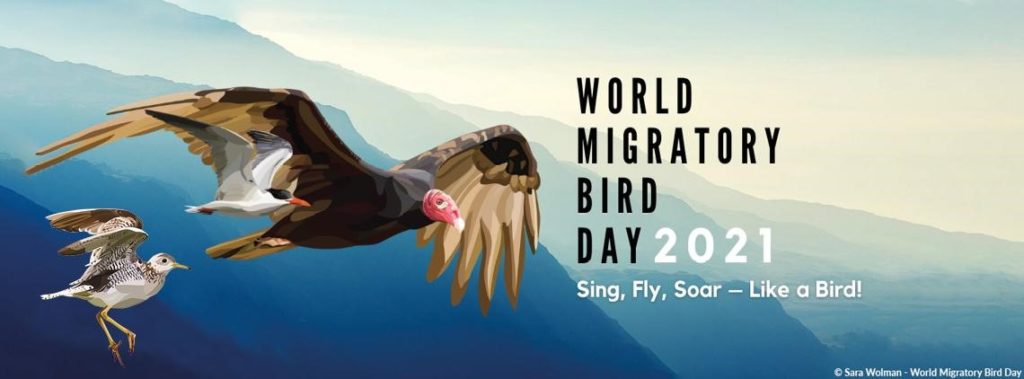Fall Migration Celebrations: World Migratory Bird Day, 2021
‘Sing, Fly, and Soar’ is this year’s theme for World Migratory Bird Day, which focuses on celebrating the tremendous journey migratory birds take each year as they begin to head down to South America for the winter months. This year’s #WMBD2021 theme also encourages bird lovers and naturalists across the globe to use their voices to speak up about their passions to conserve the habitats of migratory birds.
As many of our migratory bird populations, such as the Eastern Wood-Pewee, Piping Plover, and Warbling Vireo, make their way back to their overwintering homes in South America, we would like to take a moment to look at some of the key conservation priorities and programs that Nature Canada has for protecting Canada’s Migratory Bird Species.

Bird Friendly Cities
Our Bird Friendly City Program is a multifaceted certification process that focuses on creating and establishing safe havens for birds within Canada’s urban environments. As cities are key flyway migration stops for birds it is critical that we do everything we can to reduce the threats that cities impose on birds such as reducing the number of window collisions, light pollution, and the rates of cat predation.
It is our goal to certify thirty Canadian cities and towns as Bird Friendly by World Migratory Bird Day, 2022. If you would like to learn more about the program or get involved with a local Bird Team near you, please visit our website or reach out to our Bird Friendly Cities Organizer.
Save Our Swallows
Aerial Insectivore populations such as Purple Martin, Barn, and Bank Swallow are in severe decline due to increased pesticide use, climate change, and human disturbance. The time to act is now and Nature Canada’s Save Our Swallows Campaign is doing just that! The Nature Canada Naturalist Team continues to work with various organizations, Indigenous communities, farmers, and researchers to monitor and track swallow populations and their roosts to deepen our understanding of the threats they face and how we can work together to protect them. Learn more about our swallow monitoring work here.
Nature-Based Climate Solutions
As climate change poses a variety of threats to migratory birds we also must come up with solutions to the climate crisis. Nature-based climate solutions such as land protection, restoration, and improved land management are just some of the avenues that can be taken to fight both the climate and biodiversity crisis. Nature-based climate solutions are a unique set of tools that can be used to help maintain and conserve critical ecosystems and habitats that support birds along their migration routes.
Protecting the Fraser Delta Shoreline
We cannot talk about migratory bird stop-over sites without talking about the Fraser River Delta Estuary (FRE) in British Columbia. The Fraser River Estuary helps to support millions of migratory bird species each year and is also the overwintering home of many shorebirds and waterfowl such as the Double-Crested Cormorant and Snow Geese. The main threats to this area and the species there include human encroachment and development. We must act now to help protect one of Canada’s most important migratory birds and salmon spawning hot spots. It is estimated that if the Fraser River Estuary is lost up to 102 species are at risk of extinction. Learn more about the Fraser Delta here and make your voice heard by writing a letter to the local MP’s in the lower mainland area.
Boreal Forest / Sakitawak
Canada’s boreal forest stretches 1.3 billion acres from coast to coast and is the single-largest terrestrial carbon storage house in the world. The boreal forest is a critical breeding habitat for billions of migratory birds across North America and is also where millions of migratory birds from South America spend their summers. Species such as Yellow-rumped Warblers and Ruby-crowned Kinglets spend their winters in the boreal forest. Protecting the boreal forest is necessary to ensure that migratory bird populations can be conserved and sustained. The 3 to 5 billion birds that migrate to and from the boreal depend on us to ensure its conservation.
Lac Seul First Nation & James Bay Cree Bird Conservation
Beginning in 2018, Nature Canada has been supporting the efforts of Lac Seul First Nation (LSFN) and the James Bay Cree Nations of Wemindji and Waskaganish with their efforts of protecting the Species at Risk found in their traditional territories. Species such as the Red Knot, Semipalmated sandpiper, White-rumped sandpiper, Dunlin are just a few of the species that call James Bay their home and are in need of protection.



